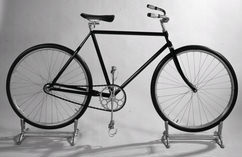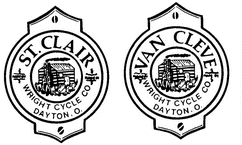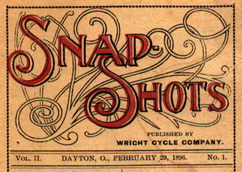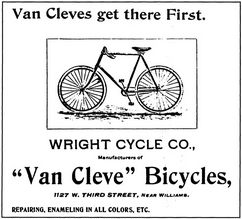|

 Up
Up 
The
Bicycle Craze

(You are here.)
 Down
Down




  Need
to Need
to
find your
bearings?
Try
these
navigation aids:
If
this is your first
visit, please stop by:
Something
to share?
Please:



|
|
Available in Française, Español, Português, Deutsch, Россию,
中文,
日本, and others.
 n
1892, Wilbur and Orville bought new "safety" bicycles and soon cycling
– or "wheeling," as it was then called – became a
shared passion. Wheeling was, in fact, becoming a passion all over the United States.
Safety bicycles were
the first practical form of personal mechanical
transportation, offering considerable advantages over the horse
especially when traveling short distances. There had been bicycles
before the 1890s, but they were hardly practical. High-wheel or "ordinary" bicycles with huge wheels in front
and small wheels in back had
been the province of daring athletes. Wilbur, in fact, had owned an
"ordinary" and learned to ride it while the Wright family
still lived in Richmond, Indiana. His training as a gymnast probably
served him well when mounting and dismounting the awkward machine. n
1892, Wilbur and Orville bought new "safety" bicycles and soon cycling
– or "wheeling," as it was then called – became a
shared passion. Wheeling was, in fact, becoming a passion all over the United States.
Safety bicycles were
the first practical form of personal mechanical
transportation, offering considerable advantages over the horse
especially when traveling short distances. There had been bicycles
before the 1890s, but they were hardly practical. High-wheel or "ordinary" bicycles with huge wheels in front
and small wheels in back had
been the province of daring athletes. Wilbur, in fact, had owned an
"ordinary" and learned to ride it while the Wright family
still lived in Richmond, Indiana. His training as a gymnast probably
served him well when mounting and dismounting the awkward machine.
The invention of the safety bicycle, with two
wheels of equal size, made the bicycle relatively easy to mount and ride,
opening the activity to almost everyone. The Wrights joined a
local bicycle club, the YMCA Wheelmen, went on long country rides, and did a
little racing. In 1894, Orville won three medals and a rocking chair in
various cycling contests. And because their scratch-built presses had made their reputations as
mechanics, they were set upon by friends in need of bicycle repair. Soon
the Wrights had a good repair business.
Wilbur opened a bicycle shop in 1892, the Wright
Cycle Exchange. He was soon joined by Orville. The brothers retained
their printing business, but left the day-to-day running of it to Ed
Sines. In addition to repairing bicycles, they also sold new bikes and
accessories. Business was brisk, and in early 1893 they moved to larger quarters,
and then later that same year they moved again and
renamed the business The Wright Cycle Company. In a year's
time, bicycles
had become their primary business and they hired their brother Lorin to take over the print
shop and work with Ed.
 The Big Race The Big Race
After several years of repairing bicycles, the Wright brothers
decided they could build a better bike than they could buy. In 1896, they began to
manufacture the top-of-the line Van Cleve and the lower-priced St. Clair, both
named for Ohio pioneers. It was a good marketing ploy -- 1896
was the centennial anniversary of the founding of Dayton and these names
were familiar to the Wright's customers. The Wrights in fact were
descended from Catherine Van Cleve, a member of the first wave of
pioneers to settle the area. Her daughter (and the Wright's great aunt)
Mary Van Cleve has been the first person to step off the
small boat of settlers that sailed up the Great Miami River onto what
would become Dayton. The motto they chose to advertise their bikes was a
pun on their own ancestry: "Van Cleves get there first."
Wright bicycles were not mass-produced machines, but were hand-built
to a customer’s specifications. At that time, the bicycle industry was analogous to
computers today. Small-time manufacturers could build their own brands from readily
available components. The Wrights added a few original improvements, including an
oil-retaining wheel hub (designed by Orville) and coaster brakes. By 189y, they were earning $2000 to $3000 a
year in gross sales from the bicycle business, a respectable income for the times.
 The Wright Special The Wright Special
In Their Own
Words
|

A Van Cleve bicycle built by the Wright
brothers in the mid-1890s.

The nameplates for the Van
Cleve and St. Clair
bicycles.

Although bicycles became their mainstay, the Wrights
kept their job printing business until 1899. Among the jobs they
printed was "Snapshots," a humorous newsletter for their bicycle
customers.

An ad for Van Cleve bicycles and the Wright
Cycle Company. |